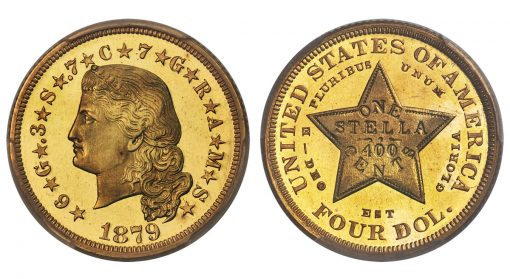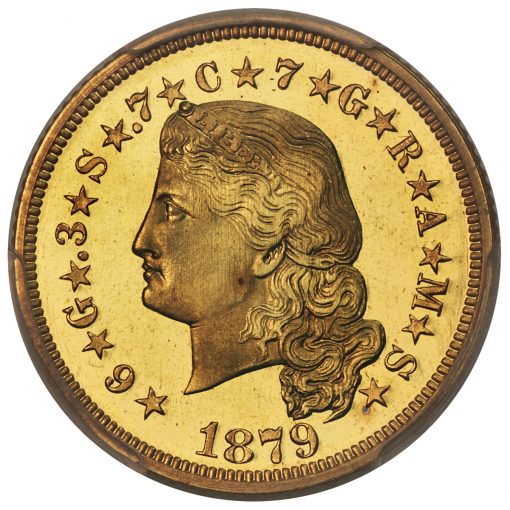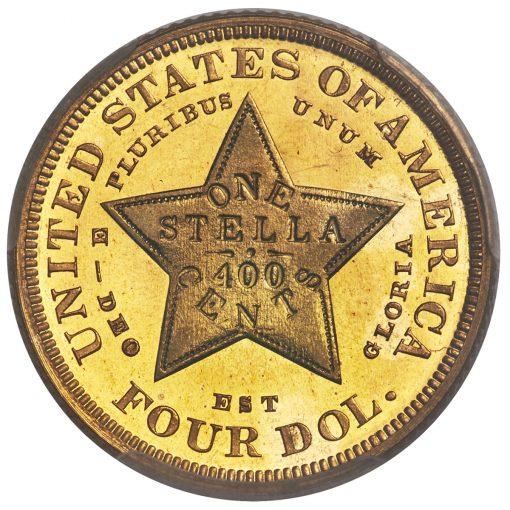A superb example of an extremely rare 140-year-old U.S. coin that sat, untouched and perhaps unknown, in a family safe is among lots in highest demand being offered at Heritage Auctions’ U.S. Coins Auction March 14-16.

This 1879 $4 Flowing Hair, Judd-1635, Pollock-1833, JD-1, R.3, PR66 Cameo PCGS sat untouched in a family safe for decades in Stockbridge, Massachusetts, discovered in an estate that included antiques and other artwork.
"These coins were only struck in 1879 and 1880," Heritage Auctions President Greg Rohan said. "The Flowing Hair and Coiled Hair stellas were struck for just a short period of time, and there is a significant amount that still is not known about the conditions of their production, which makes this extraordinarily rare coin a real numismatic oddity. The background of this relic from the late 19th century remains shrouded in mystery, only adding to the allure to top collectors."
From the 1860s through the 1880s, proposals were submitted for a new form of coinage to facilitate trade with European counterparts. Several ideas were proposed, and ultimately rejected, but the projects did yield some intriguing patterns, the most famous of which is the four-dollar gold piece, or "stella."

This example was discovered in an antique safe in a cottage in Stockbridge of the consignors’ "Aunt Mary," a community leader whose understated lifestyle belied her generosity toward family members in need. Her modest home, in which she lived for about 50 years, reflected her choice to save, rather than spend extravagantly on herself.
As her health declined, Aunt Mary coached her niece to "be careful before giving things away;" following her death, her home in the Berkshire mountains revealed that she practiced what she preached, uncovering assorted coins, a bottle of rye whiskey that was casked in 1863 and bottled in 1913, and a painting by an acclaimed 19th-century French artist: Jean-Baptiste Corot.

The coin offered here was found in an old safe among a pile of coins, including Spanish gold cobs and American double eagles. Because Aunt Mary never mentioned the coins, the executors of the estate brought them all for an appraisal with a local dealer, and were thrilled to learn that the cache included this rare stella, the likes of which the appraiser had not seen in about three decades. The local appraiser never had seen a stella and referred the family to Heritage Auctions.
Philadelphia-based inventor and renowned self-promoter Dr. William Hubbell is credited with the coin’s design. The longtime Minister Plenipotentiary to Austria-Hungary, Rep. John A. Kasson, was associated with coin, having suggested a coin of equal value — $3.88 — to the standard gold pieces of the Latin Monetary Union. But Hubbell modified Kasson’s idea and used it as evidence to support his plan for a four-dollar gold piece that would solve the international coinage problem.
The coin is a treasured prize among serious collectors, in part because it was produced for such a short period of time and in such limited number. Mint Director Horatio Chapin Burchard instructed Philadelphia Mint Superintendent A. Loudon Snowden to have the stellas struck. The result was a group of just 425 struck Flowing Hair stellas. (It should be noted that about 20 1879 Coiled Hair, 20 1880 Flowing Hair and 20 Coiled Hair 1880 Coiled Hair four-dollar gold patterns also were struck, most likely for well-connected coin dealers and collectors.)
To learn more and see images of the rest of the 2,808 lots in Heritage Auctions’ U.S. Coins Auction March 14-16, visit ha.com/1293.
Heritage Auctions (HA.com) is the largest fine art and collectibles auction house founded in the United States, and the world’s largest collectibles auctioneer. In addition to its headquarters in Dallas, Heritage has offices in New York, Beverly Hills, San Francisco, Chicago and Palm Beach, Paris, Geneva, Amsterdam and Hong Kong.





